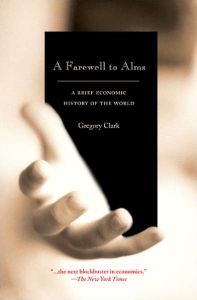
A Farewell to Alms
A Brief Economic History of the World
Recommendation
The topic of this thrilling book, 20 years in the making, is nothing less than the history of civilization, from the Neolithic Revolution to the Industrial Revolution to today. Rather than relating history as a story of kings, Caesars, popes, prelates and presidents, Gregory Clark tells the story through economic data, much of which is the result of his own analysis of documentary evidence. Almost every other page contains a beautiful graph, table or chart illuminating some dimly lit bit of history. And Clark’s detours are almost as wonderful as his main argument. His writing is elegant and clear, his sense of humor present but not annoying. While this book has outraged some commentators, it’s hard to see why, given the caution with which Clark presents his conclusions. Most likely, the flash point is his stress on culture as enabling and retarding economic growth – views that sometimes get wrongly equated with racism. getAbstract recommends this book to anyone who wants to quantitatively enhance his or her conception of human history.
Summary
About the Author
Gregory Clark, an economic historian, is chair of the economics department at the University of California, Davis.







Comment on this summary